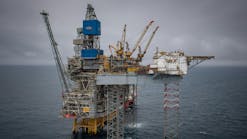Development activity during the next 3 years in the U.K. North Sea could involve 57 fields with reserves totaling 2.3 billion bbl of oil and 14.3 tcf of natural gas, says County Natwest Woodmac, Edinburgh.
More than 60% of the oil and 50% of the gas reserves lie in the central North Sea.
In similar surveys in 1989 and 1990, gas accounted for about 40% of the total oil-equivalent reserves likely to be developed. In the current survey, the gas share has risen to about 50%.
The swing to gas is highlighted by the most recently identified development prospects. These 11 fields hold an estimated 270 million bbl of oil and 2.9 tcf of gas, a 35:65 oil to gas ratio. Remaining reserves for U.K. fields producing or under development have a 60:40 oil to gas ratio.
Discovery dates for the 57 development possibilities identified by County Natwest range from 1966 for Ann field to 1991 for Julia, Elgin, and 43/24-1.
For 13 fields, more than 20 years will pass between discovery and first production. Reasons include a lack of infrastructure near fields otherwise too small to be viable.
Ann, for example, will use the Loggs gas pipeline, commissioned in the late 1980s, to carry production from the southern gas basin's V fields to shore.
Technological difficulties have delayed other development projects. Britannia gas/condensate field was discovered in 1975, but development has had to wait on high temperature/high pressure drilling advances. Franklin and Puffin also will benefit when the technology becomes available.
Some fields, such as Andrew, have simply had to wait their turns. BP, for example, has developed Bruce field ahead of Andrew.
Twelve fields will be developed within 5 years of their discoveries, which occurred in each case in 1990 or 1991. More than half of these will be subsea tie-backs, while one, Tristan field, will be developed via extended reach drilling from nearby Welland gas field.
PRODUCTION FORECAST
U.K. oil and condensate production is forecast to rise to about 2.55 million b/d in 1995, as fields currently under development and on the "probables" list come on stream.
This will take U.K. production back toward the peak level of 1988, when average output was 2.64 million b/d.
Probable developments are expected to contribute almost 10% of total U.K. production in 1995. By 2000, their share of output might exceed 35% as current producers begin to decline.
Combined gas production from the probable developments could be 3.4 bcfd by 2000, some 40% of potential gas production. This will depend on negotiation of sales contracts in an increasingly competitive U.K. gas market as well as on Norwegian imports and U.K. exports to Europe.
Copyright 1992 Oil & Gas Journal. All Rights Reserved.

